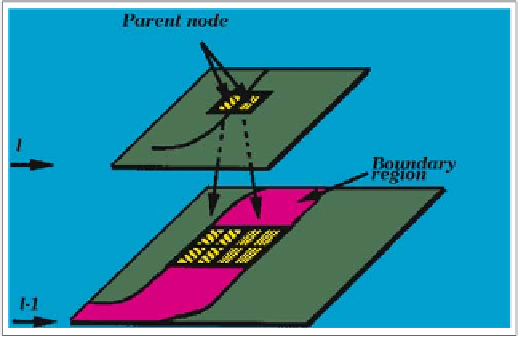Image Processing Reference
In-Depth Information
Fig. 16.5. The parent node at a boundary point of level
l
in the pyramid and its corresponding
children nodes at level
l −
1. Such children nodes define the boundary region
although it will take as many passes as the number of touching classes to terminate
the reassignment procedure.
16.6 Boundary Refinement by Oriented Butterfly Filters
The final step of the pyramidal unsupervised segmentation is a boundary refinement
procedure that gradually improves the spatial resolution of the label image
Γ
(
r
k
,L
).
As stated by the spatial principle of uncertainty [227], accurate prototypes can be ob-
tained only at the expense of the spatial resolution. Therefore, at the coarsest level,
the class uncertainty at the boundaries is higher than other points. One can reduce
it by means of orientation-adaptive filters [195]. Other methods for boundary en-
hancements include [88, 149, 150]. The spatial resolution is gradually restored by
projecting down the class labels, smoothing around the boundaries, and reassigning
the boundary pixels to their closest neighboring class. We also assume that the pro-
totypes have constant values across the different levels of the pyramid. First, at the
coarsest level
L
the boundary pixels are determined. Each pixel
r
k
is considered as
a boundary pixel if at least one label in
N
8
(
r
k
) is different from
Γ
(
r
k
,L
).Next,
Γ
(
r
k
,L−
1) is obtained by projecting down the label of each nonboundary parent
node to its four respective children nodes, i.e.,
Γ
(
n, j, l
)=
Γ
(
n/
2
,j/
2
,l
+1), where
/ is integer division.
4
The children of the boundary nodes define a boundary region
β
(see Fig. 16.5) in which the oriented smoothing will be performed. For smoothing
we need an estimate of local boundary directions. We use the linear symmetry algo-
rithm, discussed in Sect. 10.11, which defines the dominant orientation in the TLS
sense. The direction is determined by the complex number
4
Integer division is the integer part of ordinary division, e.g. 5/3 would yield 1.

